Want accessible Mopar muscle? Check out Dodge’s ’67–76 Dart
Back when Dodge Darts were regular sights on the road, nobody saw them as future collector cars. After all, the Dart was a budget compact first and foremost, the kind of thing your mom might commute to work in, then hand down to you on your 16th birthday. Most 1967–76 Darts had a humble Slant Six or a lethargic V-8 under their square hoods, puttering them from A to B and back to A again.
But the Dart had several sexier, sportier versions, and the plain-Jane reputation of the model is largely what made these sharper Darts so dang cool. Some of them were true sleepers—dog dish hubcaps and boring paint hiding the oversized eight underneath. Others threw off their pedestrian origins and shouted for attention—loud ’70s colors and hood scoops big enough to nap under. Either way, the fourth-generation Dart is yet another example that the combination of little car plus big engine plus low price can be a winning formula. Five decades after they left the showroom, these cars still offer a tempting value in classic American muscle, despite some recent price gains.
A Dart is born
Back in the 1950s, swoopy Jet Age concept cars with flight-inspired names were a regular sight on the American show circuit, and in 1956 Chrysler debuted a concept by Virgil Exner and Ghia called the “Dart,” followed in 1957 by the “Super Dart 400.” Technically, these were the first Darts, but Chrysler threw the first production, Dodge-branded darts at the board in 1960.
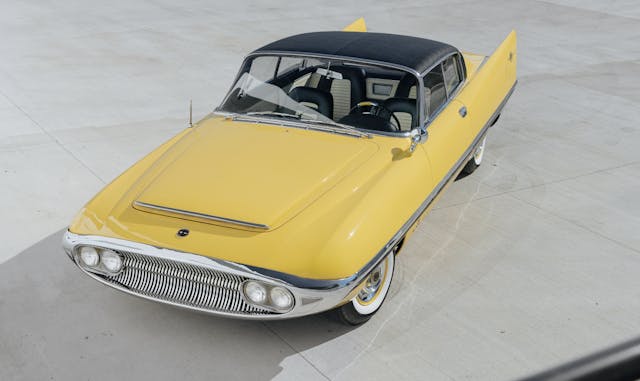
At first, market research suggested the name “Zipp” for some reason, but thankfully Dodge went with Dart for its new downsized, low-priced line. In 1963, Dodge updated its Lancer but axed that name and replaced it with Dart. That series lasted until 1966.
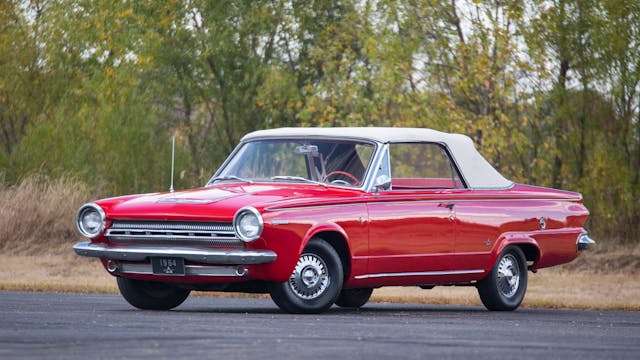
The A-body, 111-inch wheelbase 1963–66 Dart was a good-looking car. Its narrow grille flanked by huge circular headlights on the 1965–66 models are lovely features, and they bear a pleasing resemblance to the Chrysler Turbine. It was also a strong seller against stiff compact competition from the Chevy II/Nova and Ford Falcon, but for speed freaks at the dawn of the muscle car age, it was an easy car to overlook. There was only room for a 273-cubic inch V-8 under the hood—big enough for trips to work, but a little disappointing for those short squirts between stop lights.
In 1967, though, when Chrysler revamped the A-body platform (including the Plymouth Valiant and Barracuda), the Dart’s frame rails grew wider, adding room under the hood for more cubic inches. The 273 stayed on until 1969, but the options list lengthened and the Dart joined a new, smaller breed of American muscle cars. The styling, meanwhile, became more conventional with a mildly muscular three-box design. But if its lines were boring, they only added to the car’s appeal as a sleeper.
Cranking things up with the GTS
Across town, Chevrolet was doing quite well with its own compact muscle car, the Nova SS. As it turned out, plenty of buyers (especially young people) had the need for speed but couldn’t scrape together the coin for one of the bigger mainstream muscle cars. Then, as the muscle car years reached their peak and those bigger, flashier muscle cars attracted punishing insurance premiums, compact muscle cars were able to fly under the radar at lower rates for a while. So, late in the 1967 model year, Dodge introduced the Dart GT Sport (GTS) model. Little changed on the outside, but under the compact’s hood was a relatively gargantuan 383-cubic-inch V-8.
Available as a 2-door hardtop or a convertible, the GTS came back for 1968 with a 340-cubic-inch engine, conservatively rated at 275 hp, as standard. The 383 stayed on as an option. Ticking the GTS box on the order form also added Rallye suspension and a high-flow exhaust. The 383 model included beefier torsion bars, a bigger front antiroll bar, and six-leaf rear springs.
To squeeze the 383 in, the exhaust manifolds had to be modified and there was no room for an air conditioning system or a power steering pump, so parallel parking a 383-equipped GTS in the summer would be no fun at all. The 340 is considerably lighter and better balanced, plus it’s not all that much slower. It is, however, worth significantly less, and therefore a more tempting value.
But as tight a fit as the 383 engine was, a few Darts went even bigger. Hurst, the company that made shifters and occasionally dabbled in performance packages, plopped 370-horse 440-cubic-inch engines into a small number of Darts. The famous Chicago dealer Grand Spaulding Auto Sales also sold 50 of its own 440-powered Darts, called the Grand Spaulding Special (GSS).
Rare Darts with big power
In 1969, Dodge also sold a hardtop-only, M-code 440-powered Dart for drag racing, and right out of the box it could run quarter-mile times in the mid-13s. It wasn’t covered by the factory warranty, only came with a three-speed TorqueFlite automatic, and wore drum brakes on all four wheels. Going is more important than stopping in a drag race, after all. A Sure Grip differential also came standard, while 3.55 or 3.91 gear sets were available. While Dodge sold nearly 200,000 Darts of all kinds in 1969, only about 650 left the factory with the 440 engine in 1968 and ’69.

There were Hemi Darts, too, built for NHRA Super Stock drag race competition. They could hit 10s in the quarter-mile and only about 80 were built, making them one of the rarest classic Mopars. They almost never pop up for sale.
Into the Swing(er) of things
Despite its speed, the Dart GTS was a slow seller and Dodge dropped it after 1969. In its place came the Swinger 340, which included a Hurst-shifted four-speed, Rallye suspension, bumble bee stripes, and 14-inch wheels. “For the Smart Swinger…the Dart Swinger,” said Dodge. For those who weren’t of the era, Merriam-Webster defines the term in period as “a person who is lively, exciting, and fashionable,” and though “swinger” might mean something altogether different today, Dodge still saw fit to bring it back for 2023. I digress …
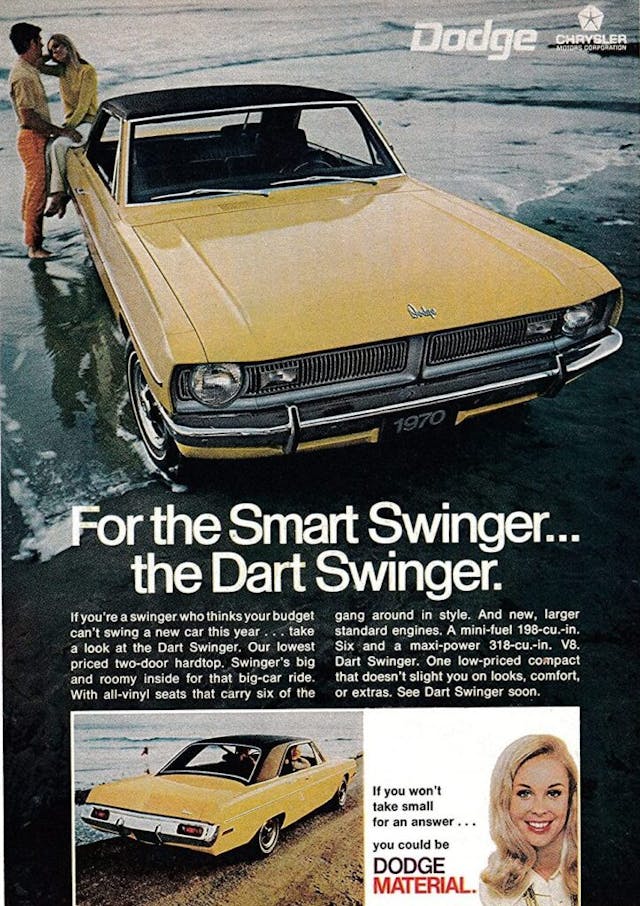
For 1970, the 383 was no longer available in the Dart, and the Swinger 340 became the sportiest available version. Even though the new Challenger got a lot of attention that year, the fast Darts remained popular and still escaped the high insurance rates hammering other muscle cars. Meanwhile, down at Plymouth, the A-body Duster was selling well and Dodge got its own version for 1971. Legend has it that it was supposed to be called the Dart Beaver, but fortunately (or unfortunately, depending on your sense of humor) Dodge went with the name “Demon” instead. The Demon 340 effectively replaced the Swinger 340 as the sportiest Dart that year, and hinted at its speedy pretensions with a dual-scoop matte black hood, hood pins, rear spoiler, and a cute little devil badge on the tail.
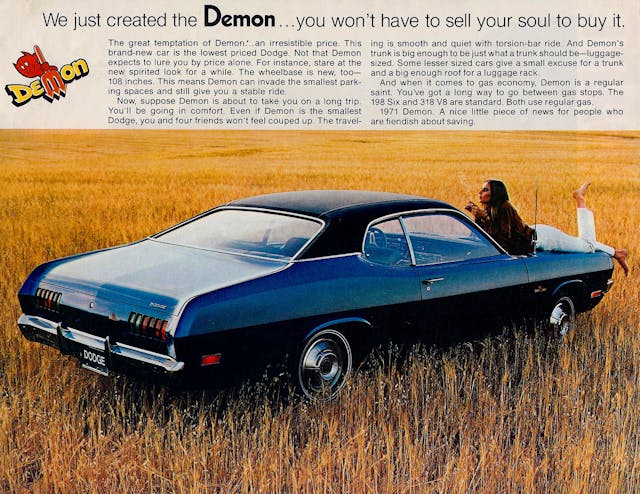
Playing up the Dart’s value for money, one ad called it a “nice little piece of news for people who are fiendish about saving” and boasted “when it comes to gas economy, Demon is a regular saint.” For 1972, horsepower was down in the Demon 340, while the devil badge vanished and the hood scoop was revised.
The Dart loses momentum
As the ’70s wore on, the Dart’s story starts to look familiar to any casual student of muscle car history. Tighter emissions rules stripped away performance and high insurance rates made ownership harder, so Mopar muscle dwindled each year. For 1973, Dodge exorcised the Demon and gave its Dart the more church-friendly name of “340 Sport.” Rated at 240 net hp, the Dart 340 Sport was the hottest in the lineup for 1973, while the Swinger lost some of its virility and made do with a 150-hp 318-cubic-inch engine. For 1974, there was a little more displacement with the 360 Sport, rated at 245 hp. But even though the high-horsepower days were in the rearview mirror, Chrysler was the best in the business at getting people to turn their heads with bright colors and loud graphics. The 1974–75 Dart “Hang Ten,” named after the surfwear company, spiced things up with Eggshell White paint, special stripes on the hood, and pinstripes down the body sides ending in graphics of a surfer catching a wave on the tail. On the inside, there were fold-down rear seats with room for a surfboard, bright multi-colored bucket seats, and orange shag carpeting. I don’t know how it could get more ’70s than that.
In 1976, Dodge capitalized on the USA’s bicentennial as a marketing opportunity with the Dart “Spirit of ’76” edition. White paint flanked by pinstripes in red, then blue ending in a profile of an eagle that would make Uncle Sam proud. “Spirit of ’76” decals called out from between the door and the rear wheel as well.
Other than the decals and loud paint, things didn’t get any more interesting for these Disco-era Darts. Sales for 1976 fell to their lowest in years, and for 1977 the F-body Dodge Aspen took up the Chrysler compact mantle. The Dart badge survived in Mexico and South America for a few more years, but the Dart we knew and loved here in America was gone.
The Dart market
When it was new, a V-8-powered Dart appealed to value-oriented buyers who were drawn to speed and fun per dollar. That’s still true today, at least relative to other classic muscle cars. Dart values have tracked mostly steady for quite some time, aside from a slight dip during the 2008–09 recession, a bump in the late 2010s, and a sizable increase during the classic car boom in the early 2020s. Besides the rarest and most exotic performance models, they’re still quite attainable. The median #2 (Excellent) value for 1967–76 Dodge Darts is $14,200, while the average #2 value is $22,500. 1968–74 Chevy Novas, by comparison, carry a median #2 value of $22,100 and an average of $37,800, while 1966–70 Ford Falcons carry a median #2 value of $13,800 and an average of $15,000.
The holy grail of classic Darts, naturally, is the ultra-rare Hemi Dart. Of the few that have come to market, a highly-original Super Stock drag car sold for $330K in 2016, and the same car sold again last year for $302,500. The next step down is the 1968 Dart GSS, which has a #2 value of $119,000. For the factory big-block 1969 GTS 440/375hp it’s $71,400. The Demon 340 and Swinger 340 come in at $42,300, while the 318- and 273-powered Darts are worth significantly less.
Moving further into the 1970s, Darts get even more affordable, and from 1973 on they get downright cheap, with perfect ones not cracking 20 grand.
Surprisingly for a car that’s been around for half a century, the 1967–76 Dart appeals to a broad range of enthusiasts, largely mirroring the composition of the collector car market as a whole. That’s saying something, given the interests of younger enthusiasts and the variety of newer vehicles entering the hobby. Credit the Dart’s low price, unpretentious origins, and customizability.
Whether it’s the terrifyingly fast, hard-to-find big-block Darts or the decaled Darts of the ’70s, these cars are overall affordable and eminently tunable. For those who like to wrench, there are many avenues to personalize and improve a Dart without a lot of coin, and buying one for casual enjoyment won’t break the bank, either.
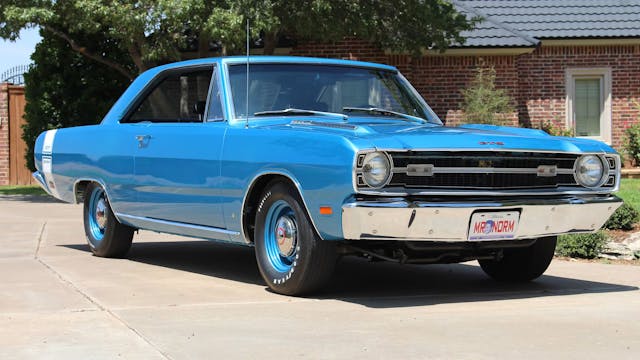
***
Check out the Hagerty Media homepage so you don’t miss a single story, or better yet, bookmark it. To get our best stories delivered right to your inbox, subscribe to our newsletters.

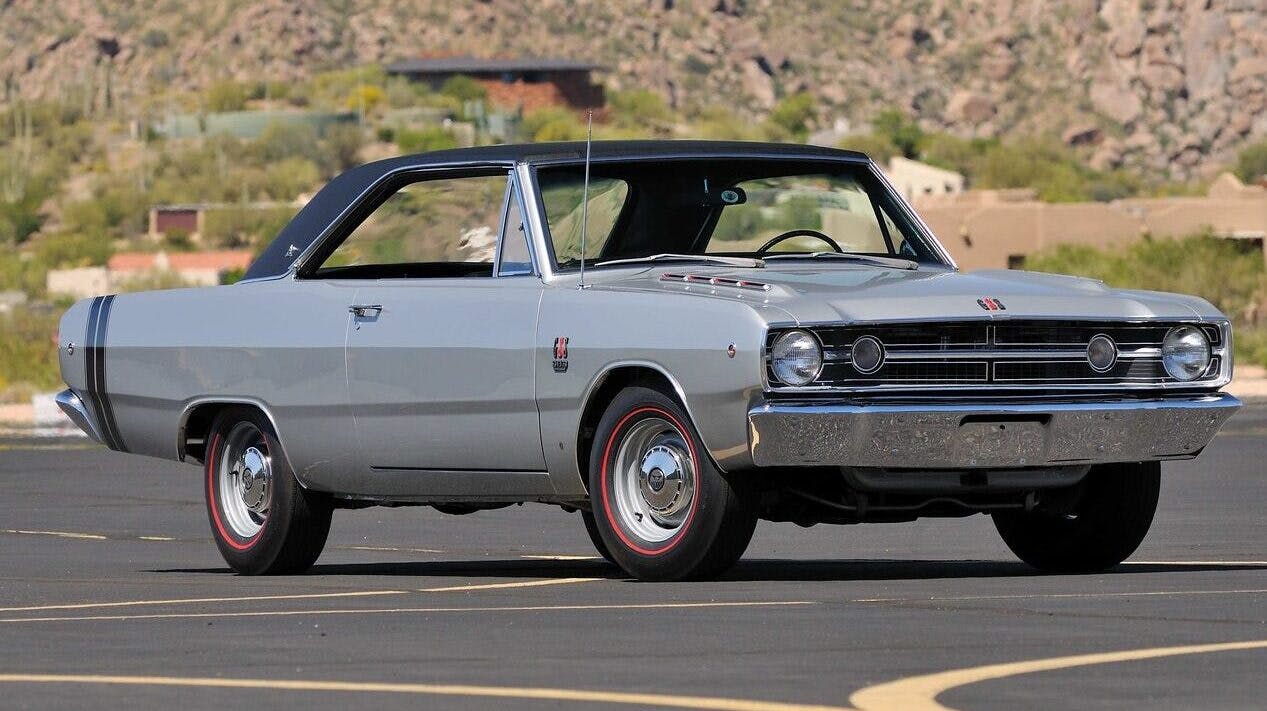
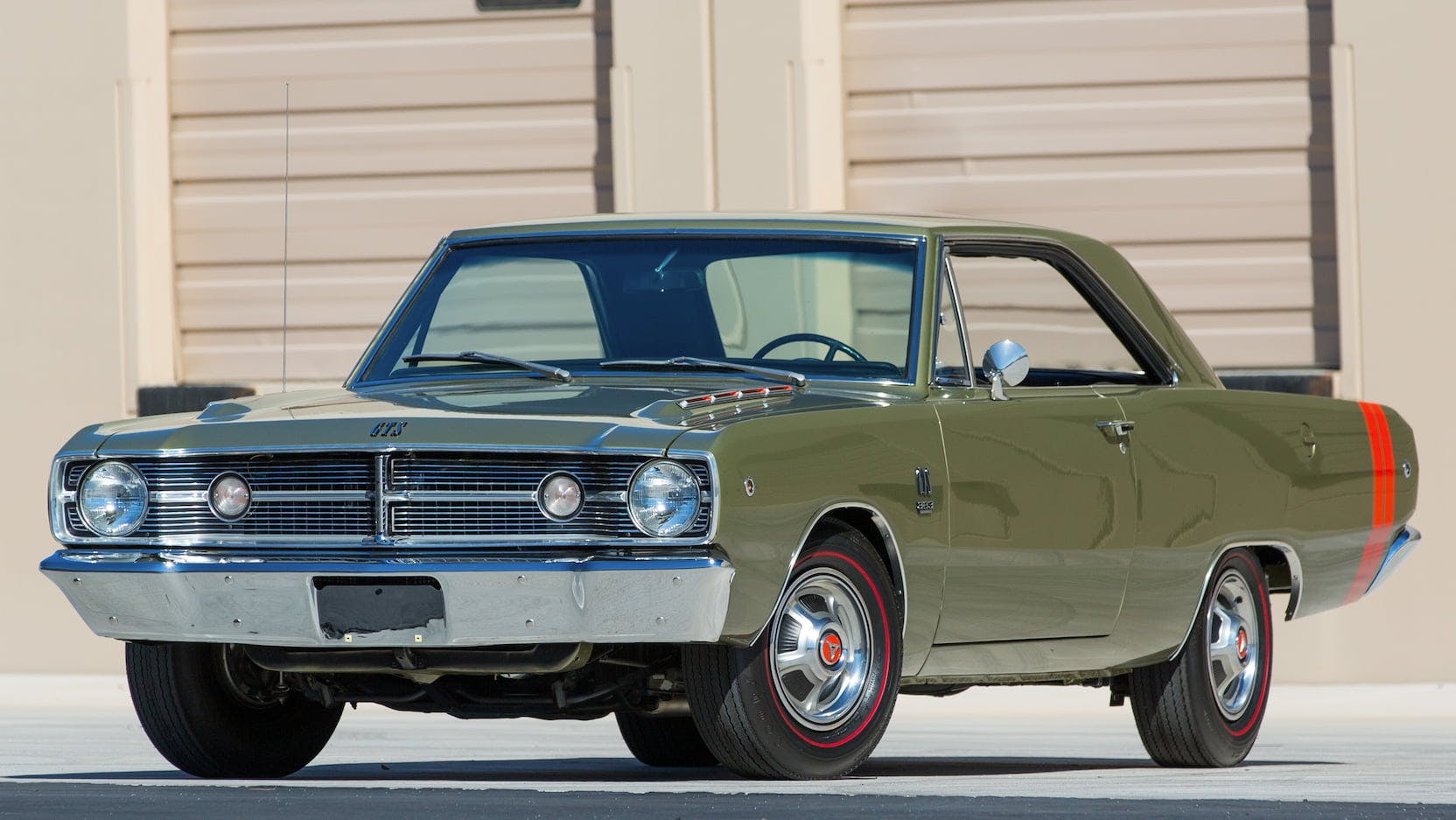
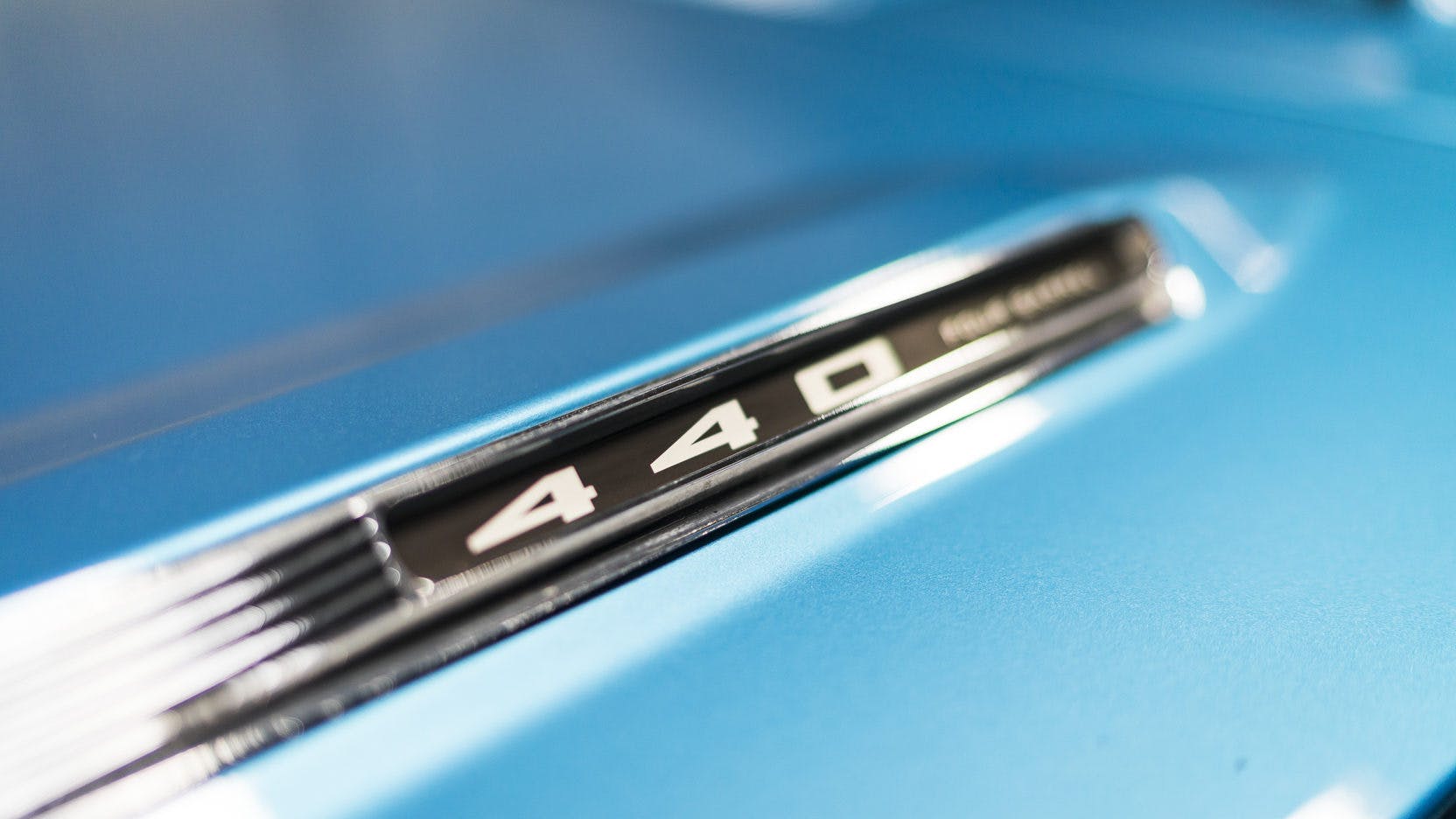
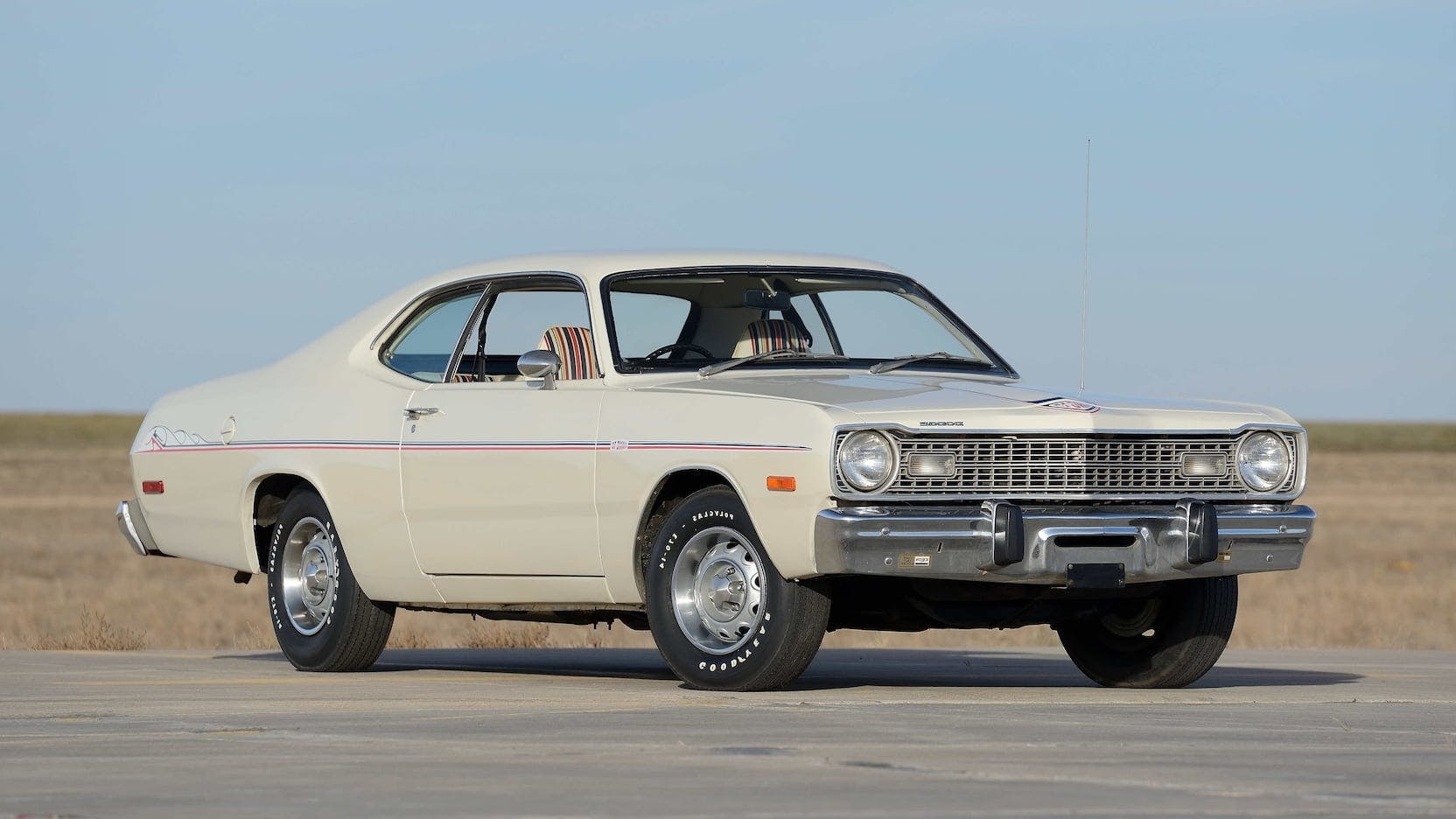
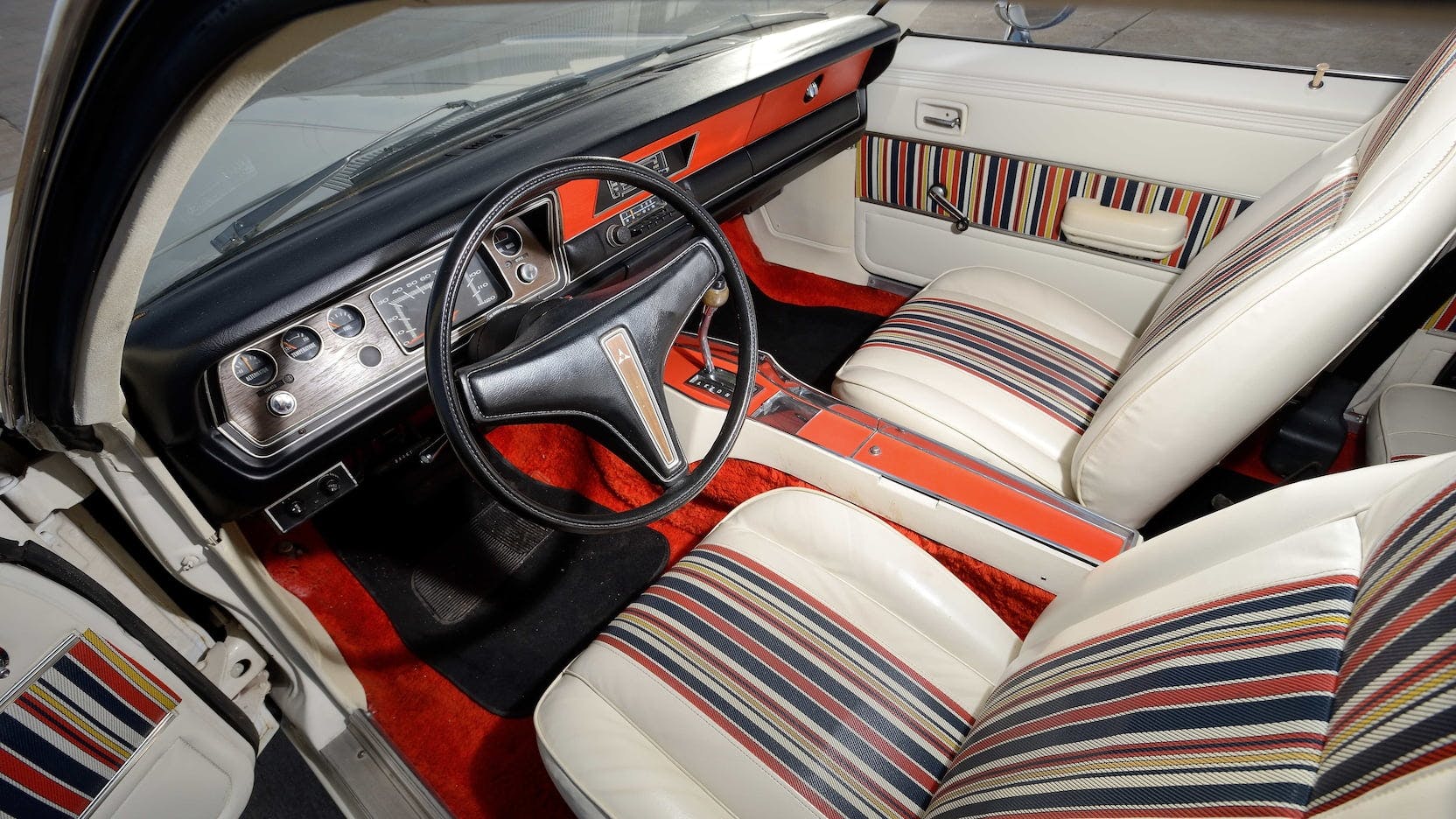


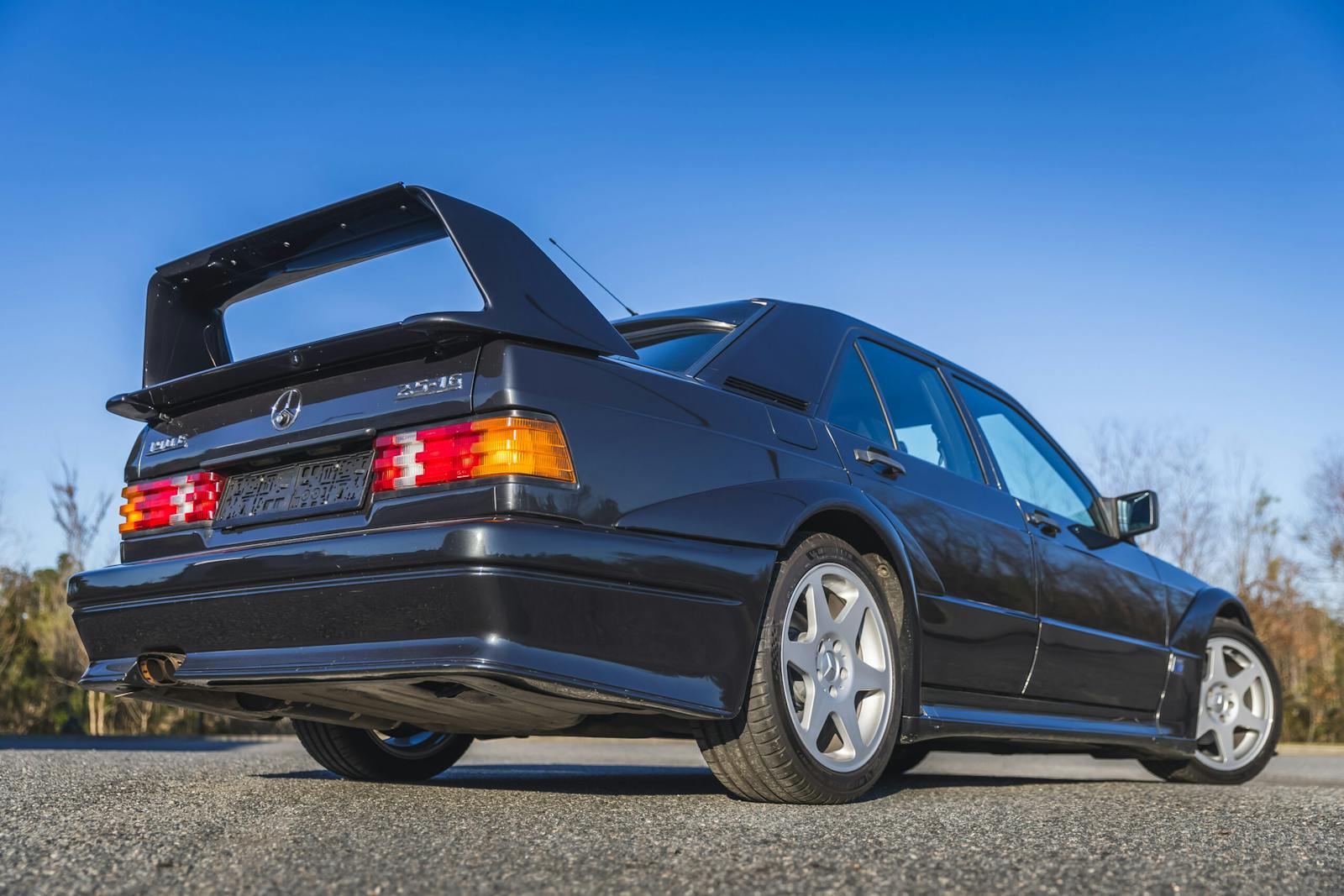
My Friend, Bob L sublet some space from me in 1997. He always had a few interesting cars for sale, some of which we helped him repair. Of all the great cars that ran through his dealer, I remember a Bronze 69 340 GT. It was tight, handled well, and shifted with a precision and firmness that made it a Great Experience. I never had that balance in any other muscle car.
I still have my first car I bought from my neighbor. It’s a 1971 340 dodge demon. It’s fully restored, matching numbers. Tor red color
In 1968 the 340 powered beat the 383 powered Dodge Dart GTS in stoplight races everytime. NHRA placed the 340 in E Stock class and the 383 in D Stock. The 383 rarely if ever made up the difference in the quarter mile. In 1969 Dodge made some suspension changes to improve the 383 performance. I raced both and can attest to these facts.
This is definitely correct. The 340 models also handled better. However, it is still cool to have a 383 or 440 in a Dart.
Yep! I had a ’68 Barracuda I bought new with a 340 / 4spd that was a definite rumpedy rump. The 1st half of ’68 the 340s with a 4 spd had a more aggressive cam than the autos. It was discontinued I think because of the rougher idle. Mine could do low 14s in the quarter with just open headers on street tires. I could walk away from any big block car (any brand) at 30-40 mph flooring it. Mine was a notchback coupe which was kind of rare as most people bought the fastbacks
Interesting but kind of bland to me. Good sleeper.
One of my earliest hot road memories was as a youngster of 10 or 11. A late teens early 20’s fella that worked with my dad at his Tool & Die shop had an orange swinger 340/4 speed that they rebuilt the motor in. Being a young lad I was thrilled when I got to shotgun on a McDonald’s run while working there during summer Holidays.
Roger was kind enough to launch it in 1st at the exact moment I raised my pail of coke for a sip.
The result was predictable, still brings a smile to my face 45 years later !
Apparently he did quite well against the big blocks of the era 👍
I’m not sure how modern prices for A body Mopars can be deemed affordable, but that are indeed potent performers when a hot V8 is in the engine bay. Although good examples can be found pretty cheap (by my definition), they generally need quite a bit of work, and a drivetrain swap to be considered a “muscle car”. The Darts referenced in your article were really hot in their day, but you won’t typically find a GTS for sale in the local auto trader, and if you do, it won’t be affordable.
Those ‘Lethargic’ six cylinders and v8’s with their factory torque curves intact and better balance often were a lot more drivable than the big engines which also tended to get tampered with. Extra horsepower usually only comes in handy when you need to brag about how much horsepower you have.
The Mannix TV show had a ’68 and a ’69 Dart GTS convertibles in seasons 2 and 3 both customized by George Barris
Having owned several Darts and Dusters through the years, I can say they’re an excellent size & weight, and the sweet spot for me is the 340 version of either. Their interiors aren’t as nicely finished as their GM competitors, but they’ve embarrassed many a big-engined intermediate car between stoplights.
67-69 were the best looking, I loved their style and they still look great today. I thought the interior was great, very simple yet sporty. My grandmother needed a new car and asked what I thought. We went down to the Dodge dealership and she bought a new 70 swinger , 318, automatic, ps, pb. Black interior with black vinyl roof. Oh, did I mention it was plum crazy! She had it repainted a couple years later thought the color was just too bright for her at her age
What I would be interested in are those Canadian “Plodges” that were produced, with a Valiant front clip and a Dart rear end. (Or is it the other way around? Or both. Now I’m confused…..) Anyway–what were the performance options available on those models? Any experts out there care to comment? (Seriously, not a question I’m asking to show my knowledge in another comment. IRDK, so that’s why I’m asking….)
Around 1980 or so I bought a 69 slant six dart gt convertible in the junkyard for $100. Adjusted the lifters as it was so far out… Motor sounded and ran like new.. Drove that little rough beauty for five years then sold it for $600. One of The best cars I’ve ever owned…
Loved the Darts! We had a ’66 GT with 273 Commando & 4-speed. It was a little sleepy until I slipped in a 3.91 Sure Grip an upsized the stock Carter carb to an AVS from my ’69 RR. I added a Mr. Gasket shifter and a couple other little tweaks and she became a 327 slayer. I didn’t beat them all, but crushed enough bowties that the Chevy boys gave us wide berth.
In high school I knew a guy with a 1966 Dart 170 post coupe. Hi-Perf. 273 four barrel V8, 4 speed, AM radio, bench seat, rubber mat on the floor & nothing else; a stripper that WAS QUICK. Factory ordered that way, and it could dust off some 327 Novas. Also knew a guy with a ’67 Valiant ordered the same way. Another guy had a ’68 383 4-speed Dart GT, another very fast car.
My first classic car purchase (which I still have) is a 1967 Dart 270 4-Door. I picked it up for a steal (less than $5k in 2018) and it is factory original and complete inside and out, to include it’s original “Certi-card”. It has it’s original Slant Six/A-904 combo with close to 198k miles. The only upgrades I’ve done to it are a new Clifford Intake Manifold, Edelbrock 4bbl carb (thats about to be replaced with a Holley 2bbl, true-dual 2.5” exhaust, disc brake conversion on the front, and 15-inch Mopar steel-wheels and dog-dish caps all around. She’s finished in Chrysler paint code “EW1 – Spinnaker White”. I can’t post pictures on here, but if you ever saw the episode of “Fast and Loud” where they drop a Hellcat Hemi into a cream-colored ‘67 Dart and then drag race Freiburger and Finnegan from Roadkill, my car is identical from an exterior standpoint, plus 2-more doors. 😊 It is literally my dream car.